
WHILE looking around for a relatively short walk recently I settled on MacDougal Street, which many think of as the commercial north-south spine of Greenwich Village. Well, I thought it would be a short walk, but I got nearly 100 photos! The street runs north from Prince, just east of 6th Avenue north to West 8th, skirting the west end of Washington Square Park. Streets in this part of town are named for Revolutionary War generals. Alexander MacDougall (1733-1786) was born in the Hebrides and became a caption aboard a British privateer vessel before switching sides and joining the Revolution. When captured and imprisoned, there were so many visitors, appointments had to be set up. Rising to major general, he succeeded Benedict Arnold in defending West Point. When independence was won he became a representative in the Continental Congress and first president of the Bank of New York. He passed at the young age of 53, though that was later than average in that era.
info: The Street Book, Henry Moscow, Hagstrom 1978
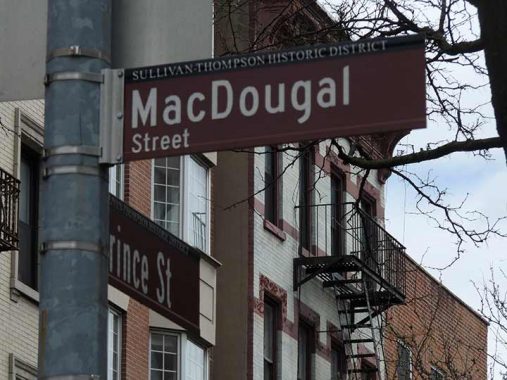
For years I had labored under the impression that MacDougal was spelled with a small “d.” I may have seen it on a vanished street sign, though the Department of Transportation is hardly infallible. When the street was laid out from 1813-1828 somehow an “L” was lopped off the end of the name. (This is nowhere near as bad as what happened in Williamsburg, where misunderstood handwriting turned “McKean” into “Keap.”) An “a” also snuck in between the M and c. The new signs are correct.
MacDougal is shorter than its parallel streets, Sullivan, Thompson, etc. after which a small historic district is named. Why? Let’s take a look.
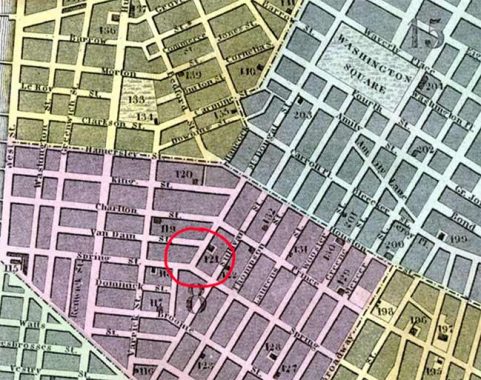
Here’s an excerpt from a Cowperthwait map of Manhattan from 1850. MacDougal once extended as far south as Spring Street, but not as far as Canal, like its brother streets, Sullivan and Thompson. If it were laid out further south, it would have interfered with the SoHo and West Village street layout.
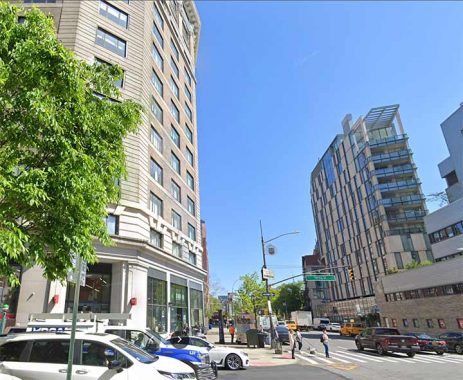
Spring Street, you say? Today MacDougal begins a couple of blocks north, at Prince. What happened to the south end? I’ve always been fascinated with 6th Avenue south of Bleecker, because that’s the “newest” section of 6th Avenue, even though it’s about a century old in 2025. The IND subway was constructed here in the 1920s and opened for service on the 8th Avenue line in 1932 and the 6th Avenue line in 1940, and was built in part so NYC could raze the 6th and 9th Avenue Elevated lines.
When 6th Avenue was extended south from Carmine Street in the 1920s it severely interrupted the existing street pattern. Some streets were eliminated entirely, some were “orphaned” and some were absorbed into 6th Avenue. MacDougal is both of the latter two.
I covered the Butterick Building at 6th Avenue and Spring street in April 2025. As you can see the building has a slanted edge, or chamfer, that considerably widens the sidewalk. The slant corresponds to MacDougal’s former route, and is the only trace of MacDougal at Spring. Across the street is Spring Street Park, which was closed for renovations from 2017-2018, open for a few years, but is now shuttered once again. It’s bordered by an odd slanted section of 6th Avenue that was once called Clark Street.
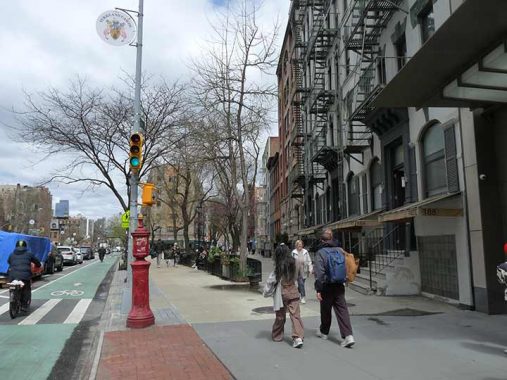
But it’s not the only slanted area along 6th Avenue. Walking north you notice some of the buildings start slanting away from 6th Avenue at Vandam Street; in fact, seven addresses in total. These buildings have 6th Avenue house numbering, but they were once on the east side of the south end of MacDougal Street.
A good look at NYC infrastructure new and old: green bike lane, North American country medallion, old style 1910s-era fire alarm.
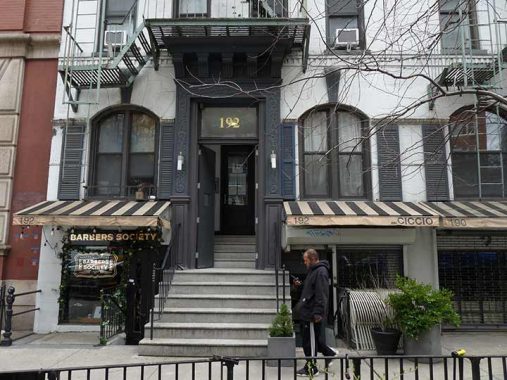
#192 6th Avenue is one of three identical buildings (188-190-192) designed by Michael Bernstein and built for Samuel Ginsburg in 1900. At 192, Barbers Society and its gold leaf window sign occupy the ground floor. All thee buildings have striped awnings above their ground floor businesses.
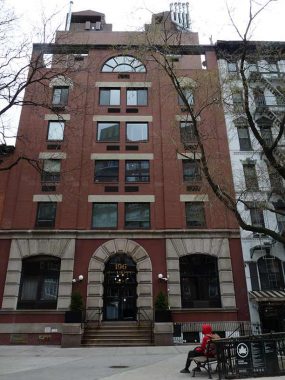
#196 was built in 1987, before the Sullivan-Thompson landmarked district was added in 2016. The original building was constructed in 1896 and designed by the architect Nathaniel Bush as the NYPD 10th Precinct and once had holding cells in the rear. When the original precinct building was torn down, the replacement you see here took its place.
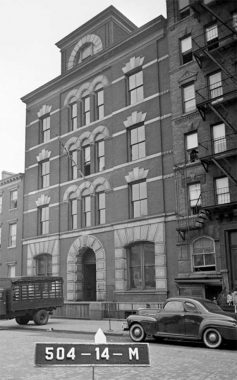
A look at this 1940 tax photo shows that the new building resembles the old with some exceptions, notably 4 extra stories. The old window lintels weren’t matched, nor where the central arched windows. But when you think about the glass-fronted nonentity that could have gone up before landmarking, it’s not bad at all.
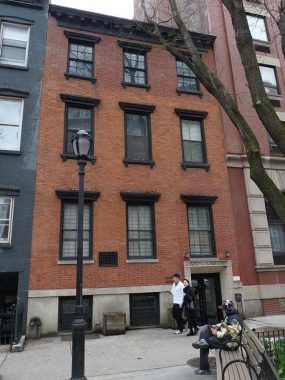
Next door, #198 6th Avenue is the oldest building facing Father Fagan Park (see below) as it was built by the carpenter and builder Richard Wight in 1831 as a modest walkup residential building. 3 story walkups like this are seen often in large swaths of the borough across the river: I call them “the bread and butter of Brooklyn residential architecture.”
Father Fagan Square/Park was established in 1928 when 6th Avenue was extended south along the new IND Subway. Father Richard Fagan, a parish priest at St. Anthony’s, perished in a fire at the rectory in 1938 while saving the lives of two fellow priests. He was 27 years old.
Born in Rio de Janeiro, Father Richard Fagan (1911-1938) moved with his family to Boston, Massachusetts as a child and later lived in Brooklyn, New York. He studied with the Marist Brothers in Poughkeepsie and entered the Preparatory Seminary at Catskill in 1926. Three years later, he graduated from St. Anthony’s Seraphic Seminary and entered the Novitiate in Pittsburgh. In 1932, he came to St. Francis Seraphic Seminary and was ordained a Franciscan priest in 1935. Father Fagan was called to duty at St. Anthony’s Church in 1936 and lived at the rectory at 151 Thompson Street. [NYC Parks]
At age 67, benches are an occasional restful respite, so I’m happy to find them here.
I have had a fascination for #205 Prince Street, corner of MacDougal, for its unusual arched window treatment and cacti collection. It gets your attention as you wander north. was constructed in 1834 for John Haff (see below). The roof, known as a mansard roof, was popular in the 1870s and was likely added around that time.
In 2009 the house was owned by filmmaker Simon Nuchtern and wife, Anna. Soho Windows mentions the cacti in the windows then, so it’s likely the building still has the same ownership; Mr. Nuchtern turns 88 this year. In 1976 he co-directed the infamous “Snuff,” which did not, despite opinion at the time, depict actual murders.
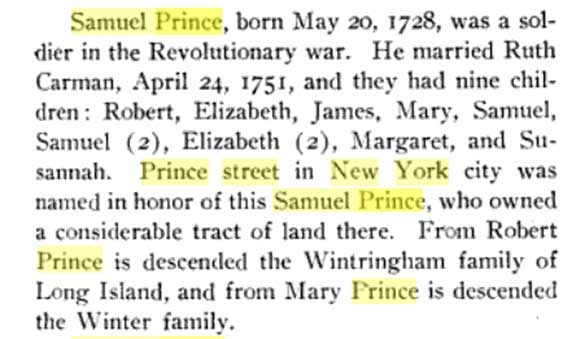
Both of the Manhattan “street books” in my possession by Sanna Feirstein and Henry Moscow claim that Prince Street is a leftover moniker from the British occupation of NYC that finally ended in 1783, but the above item that says otherwise is from the handy dandy “Historic Homes and Institutions and Genealogical and Personal Memoirs of the Lehigh Valley, Pennsylvania” by John Jordan of the Pennsylvania Historical Society, Edgar Green and George Ettinger (1905)
It’s all about MacDougal on this page but here’s an interesting item on Prince just east. #203 Prince Street is a 3-story brick residence combining Federal and Greek Revival styling and has been preserved, or more likely restored, to look the way it did when it was completed in 1834 for leather inspector John Haff. Here’s how it looked in 1940. Originally constructed with two stories, a third was added in 1888.
In the colonial period, this land was owned by vice president and assassin Aaron Burr, whose estate in what would be called SoHo and the West Village was called Richmond Hill; there are also regions of the same name in Queens and Staten Island (where Burr breathed his last in 1836). Burr occupies a unique niche in American history, patriot and villain all wrapped in one confusing whole.
The building was given NYC Landmarks designation in 1974, fairly early on because the Landmarks Preservation Commission was founded in 1965. According to Tom “Daytonian in Manhattan” Miller, the building has served as a parish house for the now-vanished Episcopal Church of Saint Ambrose and also as a funeral home; today it’s a quiet private residence.
I have walked Prince Street twice, in 2012 while sweltering in a suit after a job interview, and again ten years later.
Smooth transitions
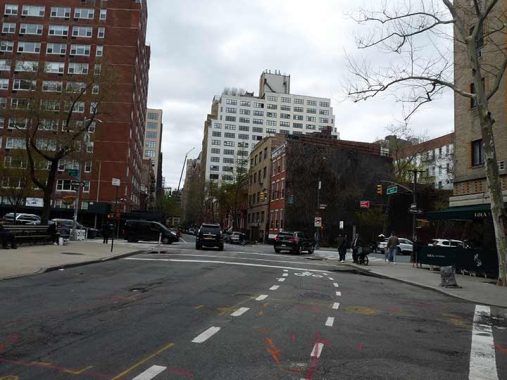
MacDougal was once the point where Prince Street changed to Charlton Street, but today it’s a traffic light at 6th Avenue. Westbound traffic flows smoothly between the two.
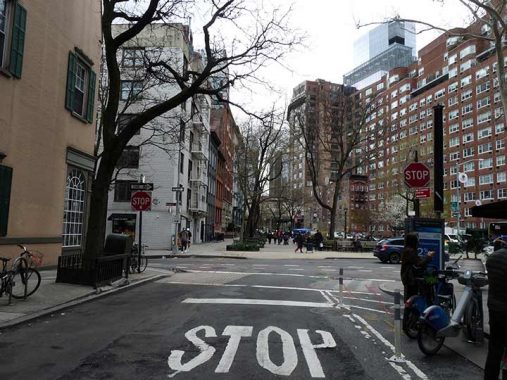
Meanwhile, a look south at the “false ending” of MacDougal Street. Looking carefully you can see the slant in the Butterick Building marking the street’s former path.
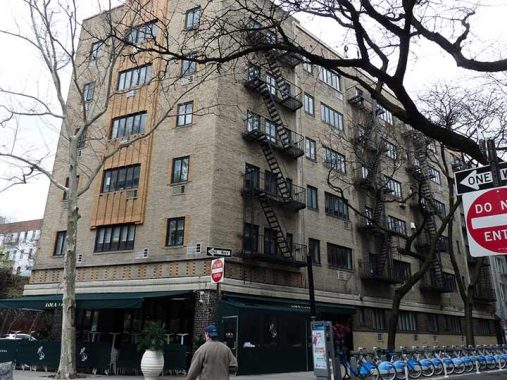
#210 6th Avenue, wedged between 6th, Prince and MacDougal, is a Moderne building built in 1928 following 6th Avenue’s opening south to Church Street the same year.
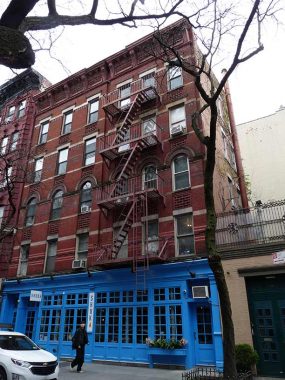
I was attracted to #38 MacDougal because of the intense blue paint job at Shuka, a Mediterranean restaurant. Yelp has over 2000 photos of the interior!
The building was built of Roman brick with stone lintels and band courses. Significant features of the
building include the second-story round-arched windows, dog-tooth brick ornament, and the Neo-Grec cornice. The
building’s historic cast-iron storefront piers were produced by the Abraham Ayres foundry. The building features a
historic fire escape. [Sullivan-Thompson LPC Report]
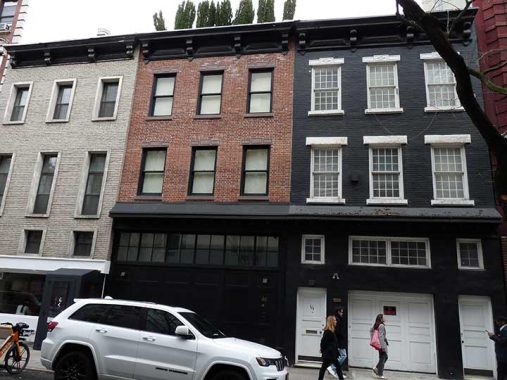
#44-48 MacDougal were brick row houses, all built in 1826, but as you can see they’ve been altered considerably before landmarking in 2016 made this much harder to do. #44 even had a garage added in 1985 in this hardly car-centric neighborhood.
#52 MacDougal, by architect John P. Schweikert, was built in 1884.
The building was designed in the NeoGrec style with Renaissance Revival style details. The building features a rusticated brownstone base with incised detail in the spandrels below the first-story windows. The upper stories were built of brick and feature brownstone stills and lintels. [LPC Report]
I was struck by the Native American with headdress above the front entrance.
It’s a bit tricky in this part of town because you never know what LPC-designated historic district you’re in! At King Street, the west side of MacDougal is in the Charlton-King-Vandam landmarked district, one of the earliest designations in 1966; while the east side remains in the Sullivan-Thompson historic district.
King Street is rather unique. It’s the only West Village street in the CKV historic district to sneak across 6th Avenue to MacDougal. The building on the NW corner, #43 MacDougal, is a preservation success story. By 2011, despite being in a historic district, it had deteriorated to the point of collapse. Built in 1846, it sat empty for over two decades. King Street was named for colonial-era Congressman and ambassador Rufus King, whose mansion in Jamaica, Queens is now a museum.
As Village Preservation reports, the building, finally under new ownership, began an 8-year preservation rebuild that was complete by 2019.
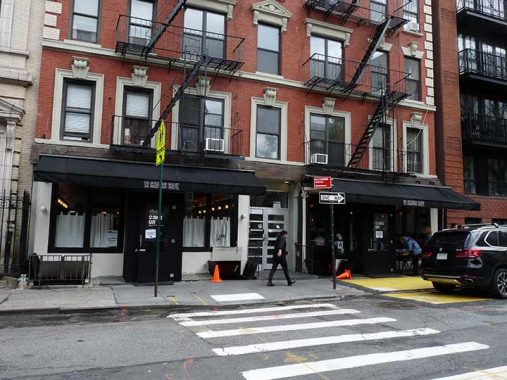
The title “The Twelve Chairs” has been used often. In 1928 it was a satirical novel by Soviet authors Ilf and Petrov, published in 1928. Mel Brooks adapted it as a vehicle for Dom DeLuise in one of its many film versions in 1970, and here the name turns up again, as a restaurant at #56 MacDougal, serving Middle Eastern and Mediterranean dishes.
The now-demolished 3-story walkup #54 MacDougal, originally on the right, was the Rosenberg Jewelry Store in the original “Men in Black” in the 1990s.
St. Anthony’s School is now the Cooke Center Academy. the school once served the gorgeous St. Anthony of Padua Catholic church a block to the east at Sullivan and Houston.
This building was designed by Nicholas Serracino in the Renaissance Revival style and built in 1909. The building
is built of buff brick and features white terra-cotta trim. The first story features separate boys’ and girls’ entrances.
Characteristic features of the style include the entrance surrounds, which feature scrolled brackets supporting
pediments that incorporate a cross. The building’s splayed lintels with keystones at the first story and molded terracotta window surrounds on the second through fourth stories are also typical of the style.
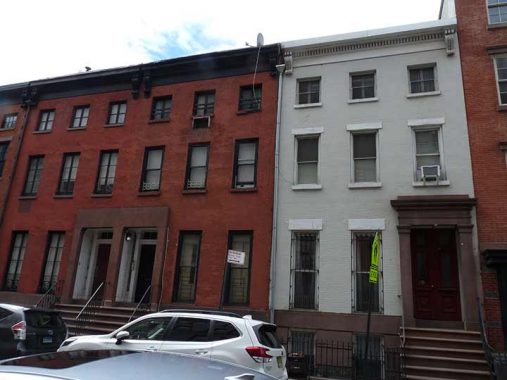
A look across the street to the west side of MacDougal, in the CKV landmarked neighborhood. Unfortunately the 1966 typewritten report doesn’t list separate buildings — that came in later years — but I can guess these simple brick walkups date to the 1820s or 1830s.
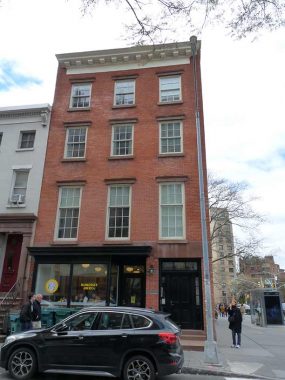
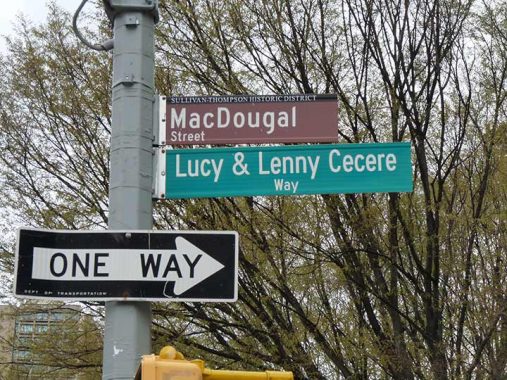
I am capable of ingesting hamburgers 3 times a week, if not more, so I’ll have to check out Hamburger America, #51 MacDougal, corner of Houston. The location was formerly Something Special, a shop frequented by the likes of Patti Smith, the Beastie Boys, Matthew Broderick and Sarah Jessica Parker. The street corner is subnamed for the shop’s founders.
After they bought 51 MacDougal Street in 1962, Lenny eventually took over the retail space on the ground floor, turning it into a store called “Something Special,” selling doughnuts, bagels, candy, greeting cards, and eventually renting mailboxes and copying keys. In this capacity Lenny became a beloved and widely known fixture in the community, whom countless Villagers, famous and everyday, came to rely upon for essential services in their daily lives. [Oldstreets]
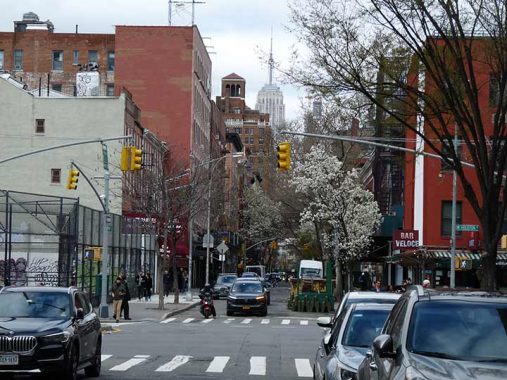
A look at the King of All Buildings, peeking above MacDougal looking north from West Houston.
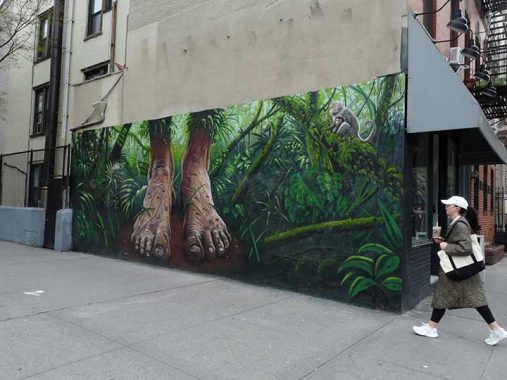
Mural by Mike Makatron (Mike Maka), SE corner Houston and MacDougal.
I had never been on the stretch of MacDougal between Houston and Bleecker, so I had never before seen this handsome grouping of attached brick buildings painted in tasteeful, unobtrusive colors. They are part of another Landmarks Preservation Commission designated historic district, MacDougal-Sullivan Gardens, which as you may expect extends a block east to the west side of Sullivan. The district is also one of NYC’s oldest, designated in 1967. The houses were constructed between 1844 and 1850, but had become run down within a few decades until they were purchased by William Sloane Coffin Senior of W&J Sloane Furniture, who developed them into what was, at the time, affordable housing; today, of course, space here is very expensive. Coffin Senior’s sun, W.S. Coffin Jr., becaue a well known clergyman and peace activist.
If you’re from Flushing you know the clock-towered W&J Sloane Furniture Building on College Point Blvd., which became a Serval Zipper factory and is now a U-Haul center.
Just recently, FNY featured a former German target shooting society on St. Mark’s Place. As it happens, here’s an Italian version, housed in some handsome 3-story brick buildings from #71-77 MacDougal. The name Tiaro Segno a Nazionale Italiano can be translated as “national Italian “hit the target” club.”

In 1940 these buildings looked considerably different, with intricate wrought-iron balconies.
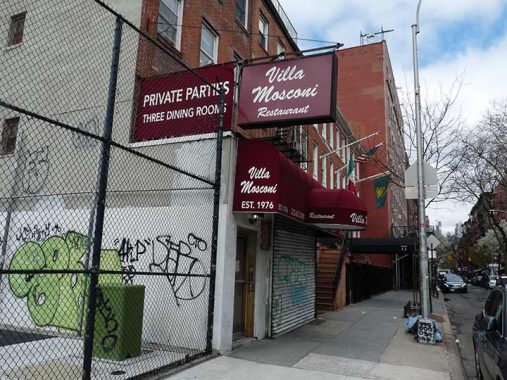
Here MacDougal edges into Little Italy. Veteran red sauce joint Villa Mosconi has held down #69 since 1976. It opens for dinner service at 3 PM and hence was shuttered when I passed.
Behind Villa Mosconi’s red awning and dated cursive sign, men who are likely lifetime members of the Tiro A Segno Italian heritage club next door slouch over veal marsala. Women wear floral dresses that recall couch upholstery from 1976, the year this Greenwich Village restaurant opened. A Carol Kane sound-alike does a very good impression of her impatient cat, waiting for her at home while she waits an hour for her check. Across the room, servers send regulars off with a hug, a doggy bag, and two cheek kisses…
The menu is short and to the point—some dishes are labeled simply “Bolognese,” “Tomato Sauce,” “Marinara Sauce”—but ask about specials and homemade pasta, and you’ll discover plenty of variety. Nothing on the table makes an urgent argument to return, yet a plate of pillowy gnocchi with pesto is intensely comforting. And if you order the tender osso bucco in a lumpy, saffron-scented mattress of risotto, a server will carry it hoisted above his shoulder, so everyone in the room can see. [The Infatuation]
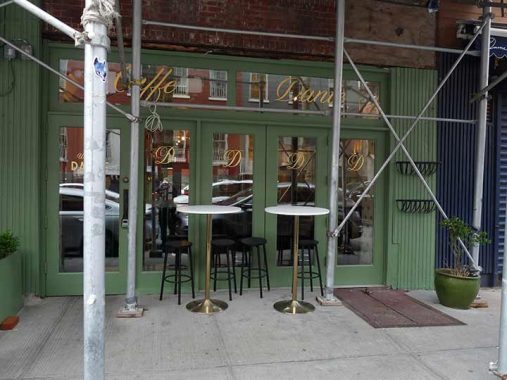
With NYC’s ubiquitous and never-ending building scaffolding it was impossible to get a decent photo of #79-81 MacDougal, a building raised in 1910 and since 1915 the home of Caffe Dante, named for the Italian Renaissance author of The Divine Comedy:
In 1915 the original Caffe Dante opened its doors on MacDougal Street in Greenwich Village, which at the time, was known as the ‘South Village’ and was mostly an Italian neighborhood. It was a local meeting place where Italian immigrants would gather over espresso and talk of home and politics.
In 1971, Mario Flotta Sr. took over space. Over the course of the next 40 years, community neighbors and celebrities alike frequented this cafe for a piece of Italy. Al Pacino, Alec Baldwin, Whoopi Goldberg, Jerry Seinfeld, and Bob Dylan were just a few of the famous faces that passed through.
In 2015, the Flotta family decided to part ways with the cafe and entrusted its future with a small New York-based Australian family. The family has stayed true to the Italian heritage of Caffe Dante whilst taking influences from the global ingredients that New Yorkers have learned to love and seek out. [Caffe Dante]
MacDougal here enters the heart of the Village and yet another LPC-designated historic district, South Village, named in 2013.
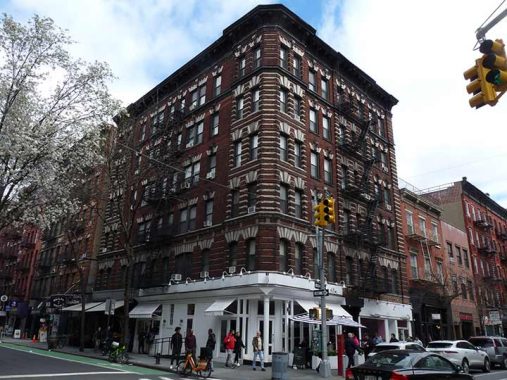
Residential housing just isn’t built like this anymore, with multicolored brickwork on the corner and huge 3-part window lintels. It was in 1904 when architects Sass & Smallheiser built #185 Bleecker, on the NE corner of McDougal. We’ve just seen Caffe Dante, and this building was also home to a longstanding Little Italy coffeeshop, Café Borgia, which closed in 2001 after 42 years.
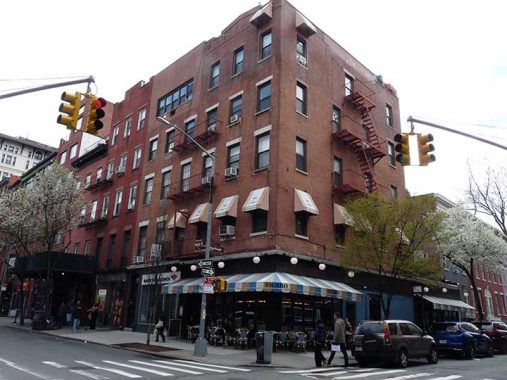
Le Figaro Cafe, now just Figaro, directly across Bleecker, was established in 1957, the same year I was. This is a “reimagining” of the original Figaro, which closed in 2008 (it was open off and on; according to NY Songlines, a Blimpie “base” was here from 1969-1975. Try finding a Blimpie in NYC in 2025.
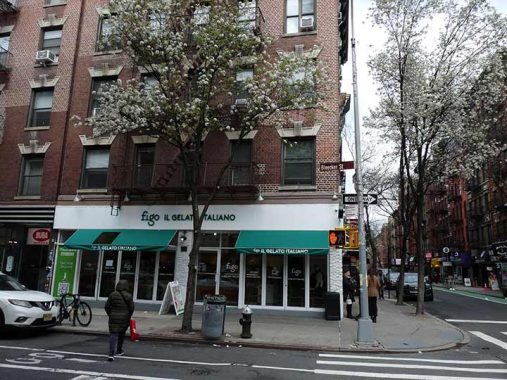
#93 MacDougal/189 Bleecker, NW corner of Bleecker, was home to the storied San Remo Cafe from 1925-1967:
The San Remo Café at 189 Bleecker St. was located on the northwest corner of MacDougal and Bleecker, occupying two storefronts. The mob-owned bar was taken over by writers and artists. Though the Italan owners and locals were hostile to gays and outsiders, they begrudgingly tolerated their business. Allen Ginsberg drank at the Remo before and after his stint at the New York Psychiatric Institute. Hanging out at the bar were writers from the Partisan Review like Clement Greenberg and Delmore Schwartz hung out there, as did the poets Frank O’Hara and W.H. Auden (on opposite sides of the bar). The bar’s literary heyday went from the end of World War II to the late 1950s. [Last Bohemians]
Mob-owned in its heyday, The San Remo bartenders were quick with the use of baseball bats on unruly guests.
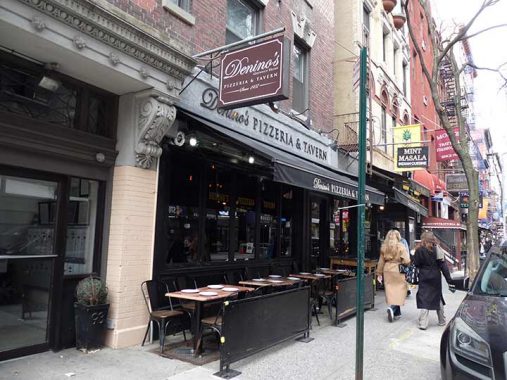
I don’t mean to make a restaurant blog out of FNY, which will always have infrastructure as a focus, but it’s hard to not talk about restaurants on the stretch of MacDougal between Bleecker and West 3rd. Denino’s has an interesting history as it opened as a neighborhood tavern by Carlo Denino in 1937 on Port Richmond Avenue near Forest in Port Richmond, Staten Island; after introducing pizza in 1951 it became one of the island’s premier pizza restaurants (in Staten Island these are a number of “pizza taverns”). Denino’s expanded to MacDougal Street in 2016 and now also has a location on the Jersey shore.
Instead of detailing everything (I have limited time), I’ll just show you the plethora of signage, neon and vinyl, new and old, on this stretch of MacDougal. Monte’s Trattoria was founded in 1918.
I was fascinated by the purple exterior of the franchise Insomnia Cookies at #116 MacDougal, but also by this odd object I found at the basement entrance.
This is a remnant of The Scrap Bar:
The Scrap Bar was opened by Steve Trimboli and ran from 1986 to 1995. According to Drew Grant, culture writer for the Observer, the Scrap Bar was “the place where punk went to die and hair metal held the wake.”
The Scrap Bar was adorned from floor to ceiling with junk, auto parts, and any kind of trash you can think of. With an infamous reputation as an underground dive where anything could, and usually did, happen, it was the hangout for the metal and hair band A-list like Guns n’ Roses and The New York Dolls who would play impromptu sets. MTV regularly threw parties and filmed at the Scrap Bar, and countless established and up-and-coming musicians saw it as THE place to be seen when in New York. [Up and Up NYC]
And:
I stumbled upon the rather poor quality video clip below of an old episode of “120 Minutes” which, for your youngsters out there, was a relatively entertaining program on MTV dedicated to so-called “alternative” rock (this, of course, being back in the era when MTV actually played music).
Herewith we see cheeky host Kevin Seal fraternizing down in the Scrap Bar circa 1988, and interviewing none other than the great Joe Strummer (looking strikingly young and slim). It’s a weird trip back through time. [Flaming Pablum]
Unfortunately that video has been lost. Whatever happened to Kevin Seal?
A door down, #114 MacDougal was the original location of Kettle of Fish, established in 1950, now at #59 Christopher.
Of all of NYC’s longstanding bars and taverns, I have somehow missed Minetta Tavern, which has held down the SW corner of Minetta Lane and MacDougal Street since 1937, but it had operated as the Black Rabbit speakeasy before that in the Prohibition era. From its early days, the Minetta was a writer’s bar and counted E.E. Cummings, Ezra Pound and Ernest Hemingway among its customers, which also included the New Yorker’s Joseph Mitchell and his discovery, wild-eyed homeless bohemian Joe Gould, who imitated seagulls and bamboozled Mitchell into believing he was producing a multi-volume, the Oral History of Our Time; in the end, it amounted to only a few notebooks of Gould’s scribbled imaginings.
In 2008, restaurateur Keith McNally reopened the Tavern not as a hardscrabble neighborhood watering hole but as an upscale, expensive French restaurant. One thing hasn’t changed, though: its hanging neon sign, which hopefully will be there a few more decades.

Minetta Street and Minetta Lane (shown here) both named for a brook that originally arouse in midtown in the Madison Square area (5th Avenue and 20th Street) and meandered southwest through Washington Square and draining into the Hudson River in a marshy area at about Houston Street. In the colonial era, it was known as Richmond Hill; in a grand dwelling built by British Army Major Abraham Mortier, George Washington made his headquarters during the Revolutionary War and John Adams and Aaron Burr later made their homes.
Deep FNY dive into Minetta Street and Minetta Lane here.
Players Theatre and Cafe Wha? share the building at the NW corner of MacDougal and Minetta Lane. Manny Roth (1919-2014) opened Cafe Wha? in 1959 in the basement of a garage constructed in 1905 that had previously been a horse stable; the trough once used for horse dung was still there. Roth converted it into a coffeehouse and performance space. When Minnesotan Bob Dylan arrived in NYC in 1960 he was employed as a harmonica player and had his first paying gig as a folksinger here in 1961. Mary Travers was a waitress here before becoming part of the trio, Peter, Paul and Mary. In the 1960s, Woody Allen, Bruce Springsteen, Jimi Hendrix, Lenny Bruce, Bill Cosby and Richard Prior all performed here early in their careers. The Cafe originally closed in the late 1960s, but it reopened in the 1980s under a new owner.
The 250-seat Players Theatre, meanwhile, has had an even longer tenure than Cafe Wha, going back to the late 1940s. For several years it has hosted A Christmas Carol — The Musical and Sleepy Hollow — The Musical, both composed by theatre owner Michael Sgouros.
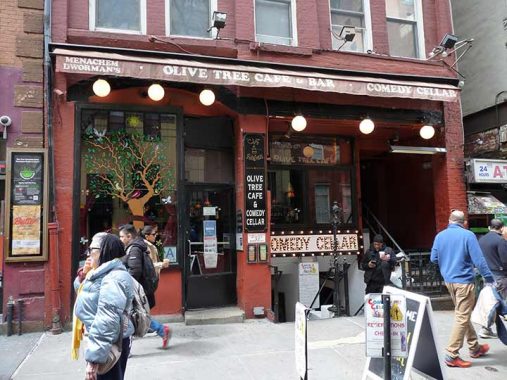
Next door is Olive Tree Cafe, which opened in 1969; in the basement, The Underground was one of the first clubs to present a light show and is now the Comedy Cellar, which helped launch Jerry Seinfeld.
At #119 is Caffe Reggio, another of the Village/Little Italy’s longstanding coffee shops, founded in 1927. It claims to be the first coffee shop in the USA to offer cappuccino. Normally, I don’t like restaurant gutter sheds (they impede photography) but at least this matches the lime green color scheme. It has appeared in Godfather II, Serpico, Next Stop Greenwich Village, and the original Shaft.
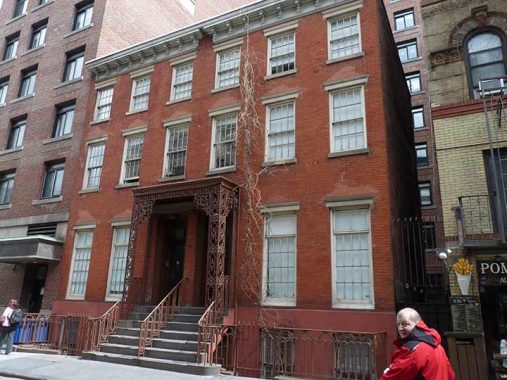
#130-132 MacDougal, just south of West 3rd across the street from Cafe Reggio, are a pair of brick buildings constructed in 1852 and share a marvelous wrought-iron portico. According to an unsubstantiated old wives’ tale, Louis May Alcott wrote the classic Little Women while living at #130. Alcott was actually in Concord, MA in the early 1850s; further research indicates Alcott wrote the book’s final paragraph here.
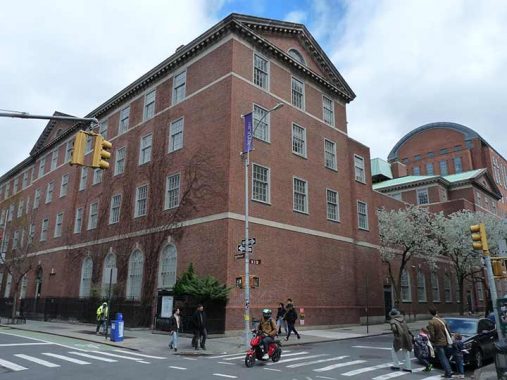
Vanderbilt Hall, #40 West 4th at MacDougal, which houses New York University’s law school, was completed in 1951 and looks older than that: it was built during an era when architects and developers still often strived to create contextual architecture that attempted to fit in with its neighbors. Nevertheless, during its development there was a considerable effort to derail it because several older buildings on West 4th and MacDougal were demolished to make way for it including former residences of authors and playwrights Willa Cather, Theodore Dreiser, Eugene O’Neill, for which it was known as “Genius Row.”
While many buildings in New York are named Vanderbilt, most are named for transportation and real estate magnate Cornelius Vanderbilt. However, Vanderbilt Hall was named for New Jersey State Supreme Court Justice Arthur T. Vanderbilt.
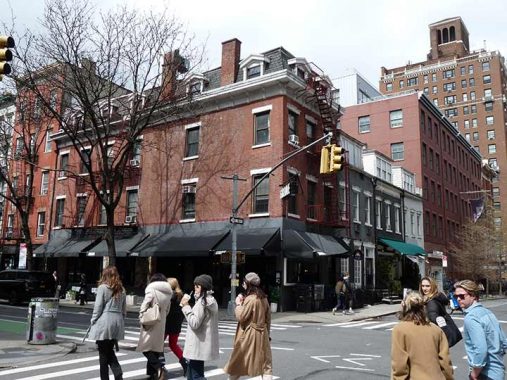
#125 MacDougal, NW corner of West 3rd, kicks off a row of the oldest buildings on the street. 125 MacDougal Street was originally built as a 2½ story Federal style house for Alonzo A. Alvord in 1829, as were the three buildings north of it. In 1868 it was given a 4th floor and its mansard roof and dormer windows. From 1901 to 1906 it was the original Knickerbocker Hotel (now in Times Square) and since 1998 the ground floor has hosted Club Groove.
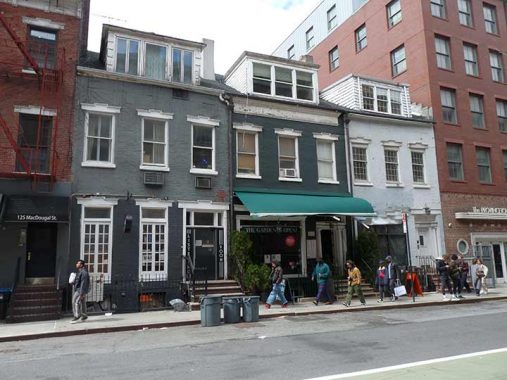
In a landmarked neighborhood, these three buildings, #127, 129 and 131 have been designated landmarks individually. All three were built for developer Alvord in 1829 and retain more of their original characteristics. Contrary to the opinion of some historians they were not built for vice president and assassin Aaron Burr.
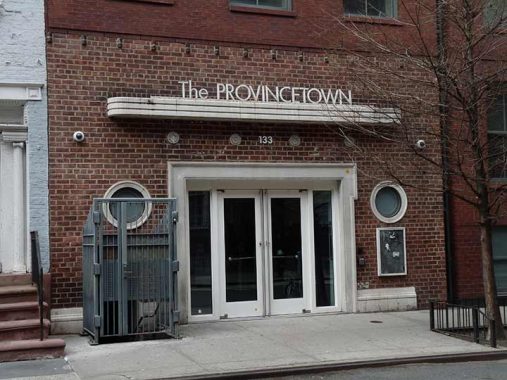
Although now demolished and replaced with Wilf Hall, the four 1830s row houses known as nos. 133-139 MacDougal Street were at the center of bohemian Greenwich Village in the 1910s and 1920s providing a home for the Provincetown Players (nos. 139 and 133), Polly’s Restaurant (no. 137), the Liberal Club (no. 137), and Washington Square128 Book Shop (no. 135). In 1984, New York University purchased the buildings, which had been redesigned into a mixed-use apartment building with a single unifying facade in 1941 by Israel L. Clausman. The New York University renovated the theatre in 1997-98 and operation was turned over to the university’s schools of education and theater. The theater is now incorporated it within [New York University’s] Wilf Hall (2004) leaving its 1941-42 facade. [South Village LPC Report]
Referred to as “the birthplace of modern drama”, the original Provincetown Players included George Cram Cook, Susan Glaspell, Eugene O’Neill, John Reed, Louise Bryant, Floyd Dell, Ida Rauh, Edna St. Vincent Millay, and Djuna Barnes. The Provincetown Playhouse staged the works of some of this country’s most well-known playwrights and talented actors, including Edward Albee, Sam Shepherd, David Mamet, Bette Davis, and Paul Robeson, among others. [Village Preservation]
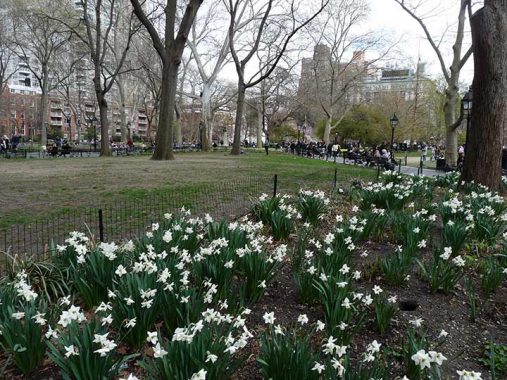
In the 1800s, NYC had something of an obsession for naming streets that surround a park for the park itself and that trend is especially in evidence at Washington Square Park, where all four of its surrounding streets have forced existing streets to be renamed. So, between West 4th and Waverly Place, MacDougal becomes Washington Square West. Other streets in the area are called Washington Place, Washington Mews and Washington Street!
All four Washington Squares…North, West, South and East…have one street numbering plan that begins at University Place and goes up when you go west, south, and east.
Here MacDougal, er, WSW, enters a thicket of high rise apartment buildings, taking advantage of the park view. I have always liked the 16-story #37 WSW, at the SE corner of the park, because of its colorful terra cotta and gilded entrance canopy.
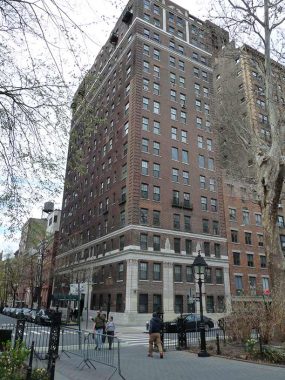
#32 WSW is a 15-story brick apartment house constructed in 1925, boasting a Washington Square address, though it’s entered from Washington Place.
I’ll emphasize the detailing on the entrance at #29 WSW at Waverly Place, constructed in 1927. Purportedly, it was the residence of Eleanor Roosevelt for 4 years after FDR’s death in 1945.
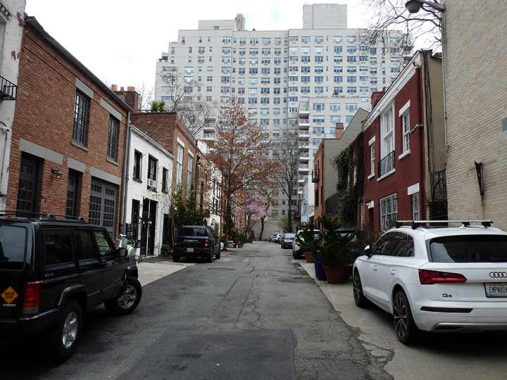
MacDougal Alley was conceived as a stable row or mews in 1833. Like Grove Court and Milligan Place further west, it’s protected by a locked gate, no doubt necessary lest hooligans from Washington Square Park trouble it. I gained admission to Grove Court many years ago, but no luck here. Its stables are described in the 1965 Greenwich Village Landmarks Preservation Report beginning on Page 126.
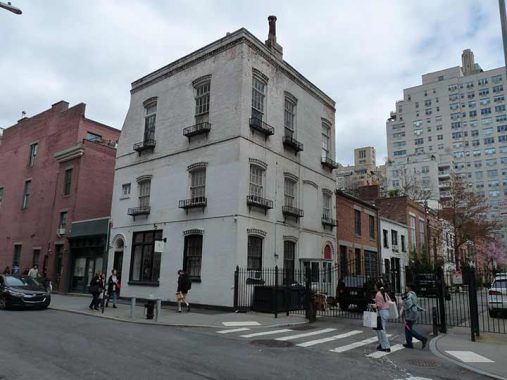
The largest of the stable buildings is the one on the corner, #176 MacDougal, constructed around 1860.
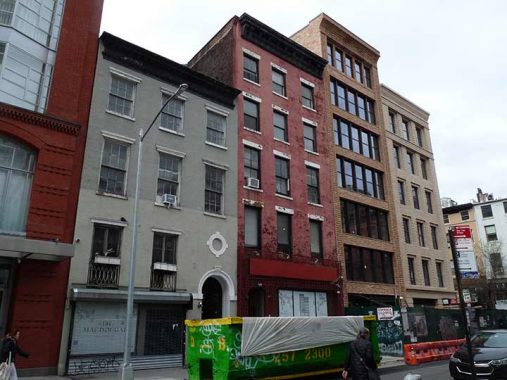
The pair of buildings in the center, just south of West 8th, were built in the 1830s with altered facades since that time.

The north end of MacDougal Street at West 8th. About a decade ago, this stretch got a set of retro version Type F posts. The new versions are stouter versions of the style, which was used for rather slight lampposts that were used mostly on NYC side streets from the 1910s through 1950s. The storefront is formerly the 8th Street Bookshop, but I remember it as an ice cream place in the 1980s-1990s, now Stumptown, a coffee franchise.
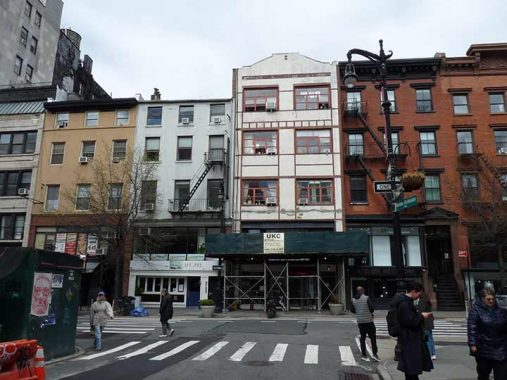
MacDougal Street’s northern progress is stopped cold at West 8th Street at a thicket of late 19th Century buildings.
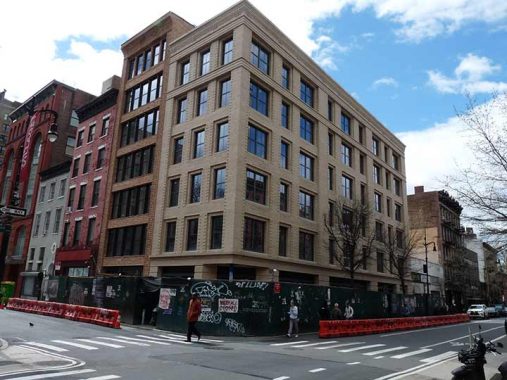
I like this new addition at West 8th and MacDougal, with its wide windows. At least it’s not glass-fronted! It replaced a one-story brick building built in 1937, hosting a number of shops.
Check out the ForgottenBook, take a look at the gift shop. As always, “comment…as you see fit.” I earn a small payment when you click on any ad on the site.
4/27/25

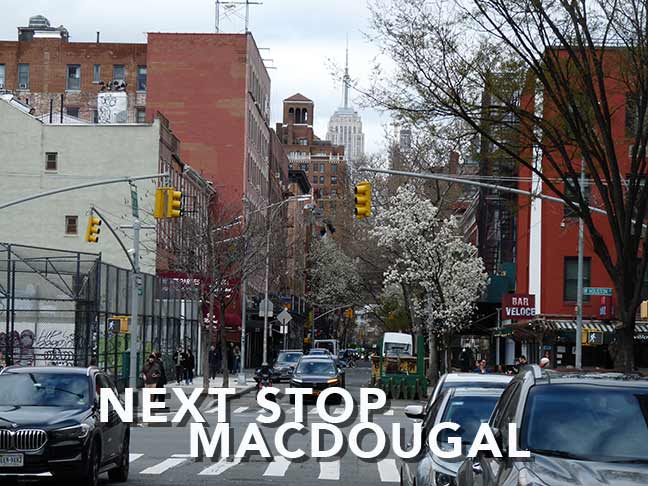
7 comments
Monte’s and Villa Mosconi are both owned by the Mosconi family.
Ed Koch was a frequent diner at Villa Mosconi.
What, no Mamoun’s? Just as much a longtime landmark as the coffee houses and bohemian folkie clubs.
Maybe you aren’t into falafel. To each his own.
Odd object at #116 is the differential from a car,also known as a rear end,then someone
welded a clevis to it,then a gear,and then probably called it a masterpiece
That differential looks very fragile, by modern standards. It might have been part of a 20 HP Model T (very little power, & not much torque to transmit).
https://www.bing.com/images/search?view=detailV2&ccid=l1JtCufi&id=511501A8FC03CB8A38F8737245744633FD30C119&thid=OIP.l1JtCufiJC5EeyK708HPPwHaFj&mediaurl=https%3A%2F%2Fbigiron.blob.core.windows.net%2Fpublic%2Fitems%2F8f3de379db774c9dade5eb547d644e93%2F1920-1925fordmodeltrearend-2_866fc4ad9da94201a9d2edcb6fb62a70.jpg&cdnurl=https%3A%2F%2Fth.bing.com%2Fth%2Fid%2FR.97526d0ae7e2242e447b22bbd3c1cf3f%3Frik%3DGcEw%252fTNGdEVycw%26pid%3DImgRaw%26r%3D0&exph=1125&expw=1500&q=Model+T+Axle&simid=607988235728348029&FORM=IRPRST&ck=442128D675359BA2F57CA3BF1DBEAC7C&selectedIndex=23&itb=0&cw=1721&ch=859&ajaxhist=0&ajaxserp=0
This brought back a lot of memories – I grew up in the Village – building 290 on 6th ave – my grandfather was the super ’66-78.
In the basement of 290, under a steel plate, gurgled Minetta Creek. I was told it ran to Washington Square Park.
The streets around 290 – Minetta Street and Minetta Lane, my old childhood playground, was once known as “dogsh*t” alley, because every dog in the Village came here to do its business lol.
I’d love to see more pics – the Provincetown, before NYU grabbed it, was a private theater and had some wild plays back in the day.
But then, the whole neighborhood was once a place for art.
Nice to see Cafe Dante, Olive Tree, Reggios, are still around. I’ll be in NY in July if you want to meetup!
Kevin,
Awesome MacDougal St. collection!
Loved all your historical details.
(I used to work a block away.)
Many thanks for preserving our precious history,
Renée in Arizona
For those who didn’t know, Pommes Frites has been on MacDougal Street between 3rd Street and Minetta Lane since locating there after the gas tank explosion in the East Village where it was originally.